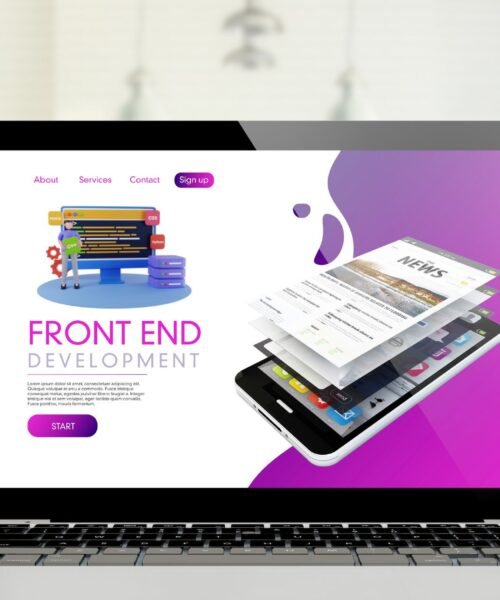Top 7 Web Development Trends to Watch
When it comes to web development, the world is ever-evolving, bringing fresh trends that shape how we build and interact with websites. As we step into 2024, it’s fascinating to explore what’s on the horizon. The digital world is buzzing with excitement as new technologies and approaches emerge, promising to enrich our online experiences. Whether you’re a seasoned developer or just starting out, understanding these trends will help you stay ahead of the curve and enhance your projects.
This year, we’re seeing a surge in innovative ideas, especially in how we integrate artificial intelligence into our workflows. But that’s just the tip of the iceberg! From creating seamless, intuitive user interfaces to prioritizing accessible design that invites everyone to the digital table, there’s so much to unpack.
Another exciting trend is the rise of progressive web applications (PWAs). These powerhouses blend the best of web and app experiences, making them super appealing to users everywhere. And of course, we can’t overlook how voice search optimization is changing the game, adapting to our evolving habits—talk about convenience!
With all these advancements, ensuring robust cybersecurity measures is critical as developers aim to protect user data and maintain trust. Plus, serverless architecture promises to streamline development processes, making it easier for teams to focus on creating stellar content.
As mobile usage continues to dominate, a mobile-first design approach is more important than ever, ensuring that websites look and function beautifully on all devices. Ready to dive into each of these trends? Let’s explore what 2024 has in store for us in the world of web development!
The Rise of Artificial Intelligence in Web Development
As we dive deeper into this year’s trends, one fascinating aspect that can’t be overlooked is the immense role artificial intelligence is now playing in web development. This isn’t just a fleeting trend, it’s fundamentally changing the way we create websites and applications. AI is like that friend who always has the best hacks up their sleeve, helping developers work smarter and more efficiently. It’s truly incredible to see how these technologies streamline processes and enhance user experience.
How AI is Transforming Web Development:
One of the most exciting developments with AI is its capability to sift through vast amounts of data and provide insights that were previously difficult to pinpoint. Imagine a tool that analyzes user interactions on your site in real time and offers suggestions for improvements. It’s not science fiction anymore, it’s happening now. Tools infused with AI can automate mundane tasks, like coding and debugging, allowing developers to focus on the creative aspects of design and user experience.
Benefits of Incorporating AI into Your Projects:
When incorporating AI into web development, the benefits are staggering. For one, AI can enhance personalization, tailoring the user experience based on individual behavior. This means your website can adapt to meet the needs and preferences of every visitor, increasing engagement and satisfaction. Plus, AI-driven analytics tools can provide deep insights into customer trends, allowing developers to make informed decisions about projects and marketing strategies.
Unique AI Tools You Should Consider:
If you’re looking to jump on the AI bandwagon, there are countless tools out there to help you integrate these capabilities into your projects. Platforms like ChatGPT can assist with content creation, while AI-driven design software can help streamline your creative process. Additionally, integrating chatbots powered by AI can drastically improve customer service on your website, providing immediate responses to inquiries and enhancing user satisfaction.
As we move further into 2024, it’s crystal clear that AI is not just a helpful addition to web development, it’s becoming a necessity. Embracing these technologies now can not only make your projects more efficient but also position you as a forward-thinking developer in an ever-competitive world. The future is certainly here, and it’s powered by the incredible potential of artificial intelligence!
Progressive Web Applications (PWAs) Gaining Popularity
So now that we’ve explored how AI is revolutionizing web development, let’s shift our focus to another exciting trend that’s been catching fire—Progressive Web Applications, or PWAs. These remarkable tools have been steadily gaining traction, and I’m here to tell you exactly why they’re the new must-have for web developers in 2024. It’s fascinating how PWAs combine the best aspects of both web and mobile applications, and they’re becoming a game-changer for businesses looking to enhance user engagement.
PWAs deliver that smooth, app-like experience right in a web browser, which means users can enjoy fast loading times, responsive interfaces, and even offline capabilities without having to download an app. Imagine a coffee shop’s loyalty program where you can collect points every time you check in, and if you lose your internet connection, you still have access to your digital card! This seamless user experience is one of the key reasons why more companies are investing in PWAs.
Why PWAs Are a Game Changer for Businesses:
Moving beyond traditional apps and websites, PWAs provide cost-effective solutions by enabling a single codebase for multiple platforms, significantly reducing development time and resources. This is especially advantageous for small to medium-sized businesses that may not have the budget to develop and maintain separate mobile and web applications.
What Makes PWAs So Attractive?
Consider this: users are now expecting instant access to information, and PWAs meet these demands flawlessly. They load quickly, can send push notifications like native apps, and have the ability to work offline. Not to mention, they can be added to a user’s home screen without the inconvenience of going through an app store. With these features, businesses can keep their customers engaged and coming back for more.
A Snapshot of Their Impact on User Behavior:
As we move further into 2024, data has shown that websites employing PWA technology see increased user engagement and retention rates. Users appreciate the speed and accessibility, which leads to longer session durations and more frequent visits. These improvements not only foster customer loyalty but also enhance overall satisfaction.
In a nutshell, PWAs are shaping the future of web development by emphasizing user experience and accessibility. Each year, they gain more followers among developers and businesses alike, and it’s thrilling to think about their potential. Here’s to the wave of innovation that PWAs are surging in with, making the online space more exciting and user-friendly.
Increased Focus on User Experience and Accessibility
As we dive deeper into the world of web development trends for 2024, let’s take a moment to appreciate the seismic shift happening in user experience and accessibility. We’re living in an age where user-centric design is at the forefront of every project. The web isn’t just about functioning applications anymore, it’s about delivering meaningful experiences that cater to a wide variety of users. This trend doesn’t just benefit those of us exploring the digital realm, it’s crucial for inclusivity and ensuring that everyone can engage regardless of their abilities.
User experience (UX) is now truly king. Websites must be intuitive, seamless, and downright enjoyable to navigate. People are becoming less tolerant of clunky designs or confusing interfaces—their time is precious, and we need to respect that. This year, expect brands to invest more in UX research and testing to tailor their online environments to user needs throughout various demographics.
Elevating Engagement through Design
The focus is on creating environments that not only look good but also work beautifully. Enhanced navigation, thoughtful layouts, and responsive designs are now non-negotiable. Developers are leaning into what we know works best for users by incorporating feedback loops that allow them to fine-tune their offerings. This attention to detail doesn’t just improve usability, it also builds trust and loyalty among users.
Making the Digital Space Accessible for All
Accessibility is another significant pillar for growth in 2024. More developers are designing websites with the goal of ensuring that everyone—regardless of ability—can access information and services. This means adopting guidelines like the Web Content Accessibility Guidelines (WCAG) and utilizing tools that assist those with disabilities. From screen reader compatibility to keyboard navigation, it’s all about creating an inclusive space that considers physical limitations and fosters equality within the online world.
Prioritizing the User Journey
To wrap up, enhancing user experience and accessibility is not just a trend, it is a commitment to creating a more inclusive web. With the continued rise of diverse user groups, understanding and keeping pace with their evolving needs will be crucial. A well-rounded approach to user experience translates to higher user satisfaction and, ultimately, better engagement. The digital world is shifting, and those who prioritize these elements will undoubtedly stay ahead of the curve in 2024 and beyond. It’s an exciting time to be part of the web development world, and I can’t wait to see the vibrant experiences that emerge as a result!
The Integration of Voice Search Optimization
As we continue our exploration of web development trends in 2024, another exciting aspect to consider is how our increasingly voice-driven interactions are reshaping the world. With the rise of smartphones, smart speakers, and voice-enabled technologies, optimizing for voice search is no longer just a novelty, it’s becoming essential. This shift means that developers must rethink how they create websites and content, focusing on natural language and user intent rather than just traditional keyword strategies.
The Shift Towards Conversational Interfaces
Gone are the days when users only typed queries into search engines. Nowadays, we casually ask our devices questions as if we’re chatting with a friend. Because of this, voice search optimization has become paramount for businesses that want to stay relevant. When building or updating a site, incorporating conversational phrases and long-tail keywords related to the target audience’s everyday language can greatly enhance visibility on voice search platforms.
Adapting Content Strategies for Voice Search
Consider how your content flows in natural speech. Think about the questions users might ask that lead them to your site. Instead of merely thinking about how to incorporate keywords, focus on full sentences and phrases that reflect actual inquiries. For example, instead of aiming for best coffee maker, strategies could pivot toward optimizing content for What is the best coffee maker for a small kitchen? Answering these questions directly in your content not only speaks to voice search but also improves your site’s overall quality.
Key Techniques for Voice Optimization
When programming or designing webpages, you might want to consider a few key techniques for voice search optimization. First, leveraging structured data markup can help search engines understand your content better. Additionally, loading times are crucial, as voice searches are often done on-the-go, and users expect fast, relevant results.
Incorporating an FAQ section on your website is another smart move. By doing so, you not only provide direct answers to potential questions but also enhance your chances of being featured as a top result in voice search. Don’t forget to keep your tone conversational—as if you’re directly addressing your audience. This approach will connect better with users and enhance engagement.
The integration of voice search optimization is a vital trend that every web developer must embrace in 2024. It’s an exciting time to be in this field, as we create more accessible and user-friendly experiences tailored to the way people truly search and interact with technology.
Serverless Architecture on the Rise
As we delve deeper into the evolving world of web development, the concept of serverless architecture is truly gaining traction. This trend isn’t just a buzzword, it’s a transformative approach that’s reshaping how developers create and deploy applications. Essentially, serverless architecture allows developers to build and run applications without having to manage the underlying infrastructure. What this means is that you can focus more on writing code and less on server management—sounds like a dream, right?
Imagine being able to scale your applications automatically based on demand without worrying about server limitations or maintenance downtime. This flexibility enables businesses to respond to user needs in real time, and that’s something we can all get behind!
Why Serverless Architecture is Gaining Attention
One of the key reasons serverless architecture is becoming popular is its cost-effectiveness. Developers pay only for the compute resources they use, making it an efficient choice for startups and established businesses alike. Instead of investing heavily in server maintenance and upgrades, companies can allocate those resources to innovation and feature development.
Moreover, serverless solutions allow for rapid deployment and iteration. With the cloud taking care of the infrastructure, teams can build and release applications faster, significantly shortening time-to-market. This agility is vital in today’s fast-moving tech world.
Features of Serverless Architecture
In addition to cost savings and speed, serverless architecture boasts several compelling features. One of the most notable is its auto-scaling capability. As traffic fluctuates, serverless platforms automatically handle resource allocation, ensuring that applications remain responsive even during peak usage periods.
Another feature is the reduced operational management burden. Developers can concentrate on writing code for their applications rather than spending time on the operational intricacies of running servers, allowing for enhanced focus on customer experience and product quality.
Key Players in Serverless Technology
When talking about serverless architecture, several major players are leading the charge. Platforms like AWS Lambda, Azure Functions, and Google Cloud Functions have popularized this model, offering robust tools that make it easy for developers to adopt serverless solutions. Their extensive documentation and supportive communities help smooth the transition for those moving to a serverless approach.
As we look ahead, it’s clear that serverless architecture is more than just a trend, it’s becoming a foundational framework for web development in 2024 and beyond. Companies who embrace this model may find themselves better equipped to innovate and compete in an increasingly digital world. So, if you’ve been contemplating how to evolve your web applications, now might be the perfect time to explore the serverless world!
Enhanced Cybersecurity Measures
As the world of web development continues to evolve, it’s crucial to address one of the most pressing concerns: cybersecurity. In an era where digital interactions have surged, so too have the threats lurking in cyberspace. With hackers finding new ways to compromise systems, prioritizing enhanced cybersecurity measures is not just an option—it’s a necessity for developers who want to create secure applications.
Cybersecurity isn’t just about a single layer of protection, it involves a multi-faceted approach to ensure that applications remain safe from unauthorized access and data breaches. It’s comforting to know that various strategies can be implemented to beef up security and protect users’ sensitive information.
Fortifying Your Digital Fortress
One of the most effective ways to enhance cybersecurity is through the implementation of robust authentication methods. Gone are the days of relying solely on simple usernames and passwords. Multi-factor authentication (MFA) has become a gold standard, adding an additional layer of security that helps ensure that users are who they say they are. For instance, sending a one-time code to their mobile device after they enter their password makes it much harder for malicious actors to gain access to accounts.
Another critical aspect is keeping software updated. Regularly patching vulnerabilities in frameworks and applications not only strengthens defenses but also builds user trust. Think of it as upgrading your home’s locks—an extra precaution that keeps your personal space secure from intruders.
Essential Tools for a Secure Environment
When it comes to implementing cybersecurity measures, the right tools can make all the difference. Utilizing web application firewalls (WAFs) is an essential defensive strategy. These tools act as filters between the web application and the internet, blocking malicious traffic and preventing attacks like SQL injection and cross-site scripting.
Additionally, employing encryption protocols, such as HTTPS, is critical for safeguarding data in transit. Encryption helps protect sensitive information—like login credentials and payment details—ensuring that even if data is intercepted, it remains unreadable.
Building a Cybersecurity Culture
However, technology alone isn’t enough. Creating a culture of cybersecurity within a development team can significantly enhance overall security posture. This involves regular training sessions for developers on the latest threats and best practices, encouraging developers to think like attackers.
Additionally, fostering communication between teams can help identify vulnerabilities before they become major issues. By instilling awareness about cybersecurity at all levels of development, organizations can create a formidable defense against potential breaches.
The digital world may be unpredictable, but a proactive approach to cybersecurity ensures that web developers can safeguard their creations and the users who rely on them. By integrating these comprehensive strategies, developers not only enhance the security of their applications but also contribute to a safer digital environment for everyone.
The Growing Importance of Mobile-First Design
With cybersecurity now firmly on our radar, let’s shift gears to another pivotal aspect of web development that can’t be overlooked: mobile-first design. With mobile device usage skyrocketing, website creators have realized that designing with mobile in mind is not merely a trend, it’s an essential part of providing users with an optimal online experience. It’s about more than just making sites look pretty on small screens, it’s about fundamentally rethinking how we approach web design in a world increasingly dominated by smartphones and tablets.
There’s no denying the statistics—more than half of all web traffic comes from mobile devices today! That means the way users interact with websites is drastically different than it was just a few years ago. With mobile users often on the go, it’s essential that their experiences are seamless and satisfying. We’ve all been there: trying to navigate a site that’s not mobile-friendly and getting frustrated with zooming in and out or battling clunky buttons.
Prioritizing Functionality and Accessibility:
When you design for mobile first, it forces you to streamline your content and focus on what truly matters. Think about it: what do users need at their fingertips? By prioritizing essential features and making navigation intuitive, you create a user-centric experience that encourages longer visits and higher conversion rates. Plus, mobile-first design places greater emphasis on accessibility, which is crucial for ensuring all users can find what they need, no matter their circumstances.
Key Elements of Mobile-First Design:
Here’s where it gets fun: implementing mobile-first design doesn’t mean sacrificing creativity for functionality. Instead, it’s an opportunity to innovate! Utilizing responsive design techniques, optimizing images, and ensuring quick load times make for a dazzling user experience that keeps people coming back. Simple, bold layouts that take advantage of mobile capabilities—like touch gestures and location services—allow you to create a rich user experience that feels unique and engaging.
User Experience is Everything:
To truly embrace mobile-first design, think about the elements that enhance user experience. Fast load times are critical because who wants to wait? The inclusion of clear calls to action guides users on their journey, while accessible font sizes and color contrasts ensure that everyone can read and interact comfortably. Sites designed with mobile-first principles not only keep visitors happy but also boost your SEO ranking, making you more discoverable when users are searching for your services or products online.
By making these considerations central to your web development strategy, you’re setting yourself up not just for success today, but also for relevance in the ever-changing digital world. Remember, in a world where more users are reaching for their phones and tablets to surf the web, mobile-first design isn’t just an option—it’s a game-changer that can propel your brand to new heights in 2024 and beyond.










